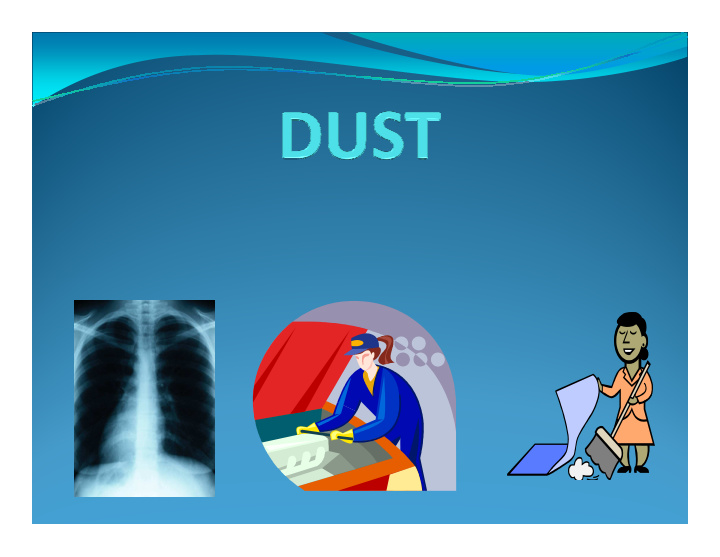



DUST � Dust is in all workplaces. � It not only affects workers’ lungs, it clogs up machinery and reduces light, resulting in machinery and reduces light, resulting in more maintenance and cleaning.
WORKERS UNLOADING CEMENT FROM THE HOLD OF A SHIP. IT IS HOT, SWEATY AND FULL OF DUST. THEIR ARMS AND LEGS ARE COVERED WITH DUST AND THEIR MASKS ARE ON THEIR HEADS. WHAT ABOUT THEIR DUST IN A QUARRY – TWO WORKERS EXPOSED WHO LUNGS? ARE WEARING NO PPE.
FACTORS • Type of dust – how toxic is it? • The size of the dust particles – can it be breathed in and get into the lungs? • The concentration of dust in the workplace and in the • The concentration of dust in the workplace and in the worker’s breathing zone. • The frequency and duration of exposure – how often and for how long are workers exposed to the dust?
EXAMPLES OF TYPE OF DUST AND EFFECT DUST HAZARD EFFECTS Silica Severe breathlessness, Bronchitis, Scarred lungs, Lung cancer. Coal Severe breathlessness, Scarred lungs (coal pneumoconiosis). Asbestos Cancer (mesothelioma, lung cancer), Scarred lungs. Scarred lungs. Synthetic Mineral Fibres Irritants. Fibres made from (SMF) products e.g. ceramic fibres, rockwool and fibreglass may possibly cause cancer if the fibres are very fine. Cotton Severe breathlessness (byssinosis). Wood Allergic reaction and/or asthma. Nasal cancer. Other animal and vegetable dusts Allergic reaction and/or asthma. Symptoms include breathlessness, dry cough and sore throat.
LOOK AT THE CLOSE UP OF DUST ON THIS MACHINE IN A TEXTILE MILL. THE BUILD UP OF DUST ON THE MACHINE MEANS IT BREAKS DOWN MORE OFTEN AND GOODS ARE SPOILT. IF THIS IS THE DUST ON THE MACHINE, WHAT IS IN THE WORKER’S LUNGS?
DUST ON A FACTORY FAN. DUST CAUGHT IN THE COBWEBS AT A FLOUR STRORE. WORKER CHECKING A LEAK OF FLOUR. HIS ARMS ARE VERY DUSTY, WHAT ABOUT HIS LUNGS? NOT ONLY IS THERE A HEALTH PROBLEM, THERE IS ALSO THE RISK OF DUST EXPLOSIONS IN THE FLOUR MILL.
DUST IS EVERYWHERE IN THIS STORE. THE BAGS ARE BROKEN. THE DUST HERE IS ASBESTOS. MOST COUNTRIES HAVE NOW BANNED THE IMPORT AND USE OF ASBESTOS. THESE WORKERS IN A BRAKE LINING FACTORY ARE USING ASBESTOS. THEY HAVE NO PROTECTION AT ALL. A FEW HAVE TIED SCARVES OVER THEIR MOUTHS/NOSES TO NO EFFECT. THEY HAVE LITTLE IDEA OF THE DANGERS OF ASBESTOS.
USING AN AIR HOSE TO “REMOVE” THE DUST! THIS IS NOT A PRACTICE TO BE ENCOURAGED AS IT SIMPLY SPREADS THE DUST AROUND ALL OVER THE WORKPLACE! OUTSIDE THE ASBESTOS FACTORY THE COMPANY SPRAYS WATER TO SUPPRESS IF YOU MUST CLEAN THE WORKPLACE THE DUST. THE BY SWEEPING, WET THE AREA FIRST FACTORY IS WITH A FINE MIST SPRAY. LOCATED IN A BUILT UP AREA AND SURROUNDED BY HOUSES!
THIS COMPANY USES AN INDUSTRIAL VACUUM TO CLEAN THE MACHINES AND REDUCE DUST LEVELS IN THE WORKPLACE.
Some managers say that they cannot invest in the price of an industrial vacuum/s – it has been clearly demonstrated that the use of industrial vacuums “pays for itself” in terms of improved working conditions (and therefore increased productivity) and reduced maintenance costs as productivity) and reduced maintenance costs as machines do not get clogged up with dust. WRONG
OFTEN WORKERS CAN BE SEEN WEARING INCORRECT DUST MASKS SUCH AS WORKERS IN PICTURES ABOVE AND WORKERS IN PICTURES ABOVE AND BELOW. HERE IS AN EXAMPLE OF LOCAL EXHAUST VENTILATION (LEV) SYSTEM ON A SEWING MACHINE. A PLASTIC TUBE SUCKS THE DUST AWAY FROM THE SEWING AREA AND INTO A SEALED CONTAINER. NO DUST IS RELEASED INTO THE WORKPLACE.
THESE WORKERS ARE WEARING THE MASKS CORRECTLY. THE WHITE DOTS SHOW THE DUST IN THE WORKPLACE. TWO WORKERS WITH NO PPE AND ONE WEARING A DUST MASK ON HIS HEAD!
SOME TIPS FOR HANDLING DUSTY MATERIALS • Prevent dust entering the workroom by enclosing the process. • Clear up spillages quickly. • Have smooth work surfaces to allow easy cleaning. • Clean regularly and systematically using a dust-free method such as a vacuum system with a high efficiency filter, or a LEV system. • Keep dusty materials in covered containers. • Do not allow pastes or drips to dry out. • Substitute with dust free materials eg. Pellets. • Prevent the body and underclothing from getting contaminated - cover the head and neck. • Have overalls which are tight fitting at the wrist and ankle. REMEMBER, SPECIAL PRECAUTIONS APPLY WITH HAZARDOUS DUSTS SUCH AS ASBESTOS!
Recommend
More recommend